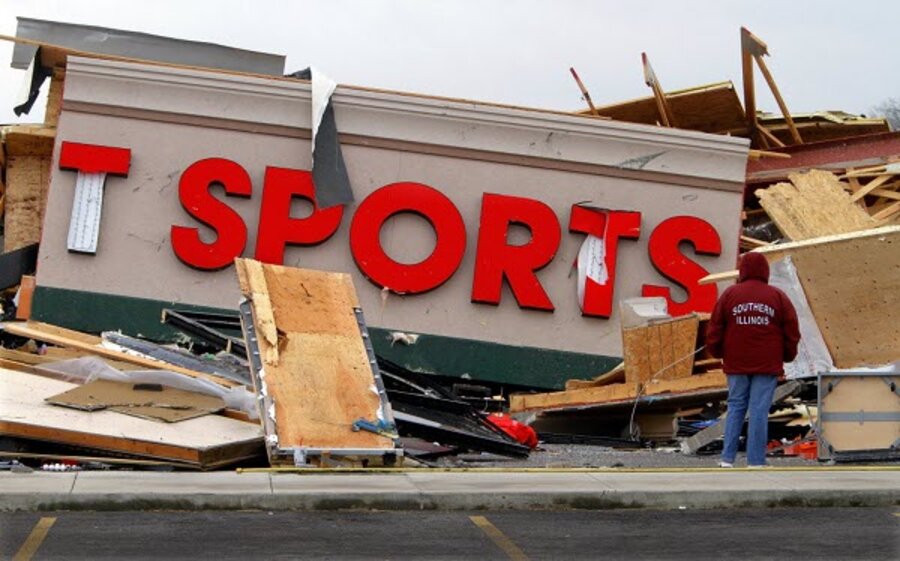Katrina in the Midwest: Tornado-struck town begins road to recovery
Loading...
| Harrisburg, Ill.
Skies darkened and emergency sirens wailed after high noon Friday in this small southern Illinois city. Residents here were just adjusting to life after a Wednesday morning tornado wreaked havoc, killing six people and injuring more than 100 others. News that another storm just as violent was brewing on the horizon added to the fatigue.
“Punishing, but it’s not like it can do anything we haven’t seen,” says Jody Farragut, who came out of her house, like many, to watch low storm clouds clotting up the sky.
An hour later, the sirens died, the storm passed minus the forecasted tornado, and life went on. But for this city, that means residents displaced from the 300 destroyed homes return to pick through the wreckage – crossing a landscape of wood, glass, and exposed nails, with home insulation wafting in the air. On Saturday, the first two of six funerals will take place.
The 200-mile-per-hour winds responsible for the destruction resulted from a powerful jet stream, combined with warm temperatures and moisture pushing up from the Gulf of Mexico, says Mike Hudson, a meteorologist with the National Weather Service in Kansas City, Mo. Now, on Friday, a violent storm front is moving east and creating “an exceptionally high risk” for the region that includes central Kentucky, southern Indiana, and southwest Ohio, Mr. Hudson says.
In the first 48 hours after the tornado hit Harrisburg, a swarm of emergency responders, volunteers, state officials, and media descended on the town of about 90,000 people. This has forced it to comprehend what happened, but also to think about how it will change the community in future years.
“Go down to New Orleans with Katrina. They’re still not back,” says Toy Dixon, while eating a meal at First Baptist Church. The church set up a temporary shelter and is receiving so many goods that they fill the hallways, stairs, and nearby sidewalk.
Yet most of the people whose homes no longer exist are not there. The people who filled the neighborhood that once was are believed to staying with relatives or friends. Some remain hospitalized.
“The people in Harrisburg will come to the aid of their neighbors in a big way and probably already have,” says Rod Sievers, a spokesman with Southern Illinois University, the largest employer in the southern half of the state. “Lots of people have extended families in these smaller towns and so will have someone to stay with. They’re not going to be left out in the cold. I’ve seen this happen time and time again.”
Many of the homes the tornado spared still do not have electricity, which is expected to return by late Friday.
Even though his home is intact, Alex Taylor, 15, waits at the church shelter with his two younger sisters while his mother talks to relatives by phone. He says the images of the tornado moving closer to his neighborhood will never go away.
“When you see it in real life, it’s almost unimaginable,” he says.
Volunteers will finally be allowed to enter the disaster zone Saturday in two shifts. They had been told to stay away as crews searched for bodies and worked on fallen power lines.
Harrisburg Mayor Eric Gregg says the “outpouring of love” from as far away as Canada is “absolutely remarkable.”
“I’m beside myself,” he says.
But it won’t be entirely a feeling of goodwill over the weekend. A contingent from the Westboro Baptist Church in Topeka, Kan., plans to picket outside the funerals Saturday and Sunday. The organization, which is known for similar demonstrations at military funerals across the United States, announced on its website that the tornado’s victims “died for the sins of Illinois.” “WBC prays for more dead Illinois rebels,” the website says.
The news has prompted plans for two counterdemonstrations. Sunnie Simmons, an organizer, says supporters will be directed to form a human wall around the funeral home and cemetery in an effort to protect families from encountering the Kansan group. A car brigade, she says, will also be instructed to block the Westboro vans at their hotel. And area tow-truck drivers have informally agreed not to tow the vehicles of her supporters, she says.
More than 1,500 people on Ms. Simmons’s Facebook page have agreed to participate. On a similar page, another 1,000 people are pledging to show up.
“I just don’t understand why they think God sent this tornado to kill us off,” she says. “It’s going to be very hard on Harrisburg people, but I think it’s good for Harrisburg to know that all the communities around them are coming together to support and protect them.”





